-
Hunting Weapons
-
Regulated weapons
-
Sporting & Leisure Weapons
-
Alarming & Self-Defense Weapons
-
Optics, Lamps and Electronics
- Optics, Lamps and Electronics
- Cameras and video surveillance
- red dot scope
- hunting scope
- shooting Glasses and tactical
- Leisure glasses & red dots
- Rangefinders and collimators
- Assemblies, rails and adapters
- Binoculars, telescopes, observations glasses
- Camera and night vision
- Talkie Walkies & radios
- Flashlights & torches
- Laser and tactics lampes
- Metal detector
- Piles & batteries
-
Hunting Defense Ammunition
- Hunting Defense Ammunition
- hunts cartridge
- central percussion Ammunitions
- Shooting & regulated ammunition
- Reloading equipment
- Reloading consumables
- Black powder ammunitions
- 22 lr, 17 HMR, 6mm & 9mm Flobert Ammunitions
- Blank cartridges, gaz cartridges and rubber bullets
- Smoke and flare
- Lead and ammunitions for airguns
- Storage boxes for bullets
-
Accessories & Bags
- Accessories & Bags
- hunting horns and whistles
- Bird calls, rings
- Town and country planning
- fox Traps and harmful, hide and camouflage
- maintenance products
- Set of cleanings and brushes
- Plates of coats, buscs and skullcap
- Gongs and targets
- Aiming, handlebar and grenadieres
- bipods,tripods and pirsch sticks
- Walking stick and seats
- Coffres & verrous
- Suitcases, rifles cases and backpacks
- Sholder bags, cartridge belts and straps
- Car equipement
- Hearing protection, masks & eyewear
-
Hunting Outfits & Acc. Dogs
-
Archery, Cutlery & Gifts
- Archery, Cutlery & Gifts
- Crossbows and tiles
- Bows and arrows
- Arrows, points and feathers
- Targeting, archery accessories
- slingshots and blowpipes
- Straight hunting knives
- Tactical straight knives
- Survival knives
- Folding knives
- Sharpeners and wet stones
- Swords and sabres
- Machette & hatchet
- Survival and to outdoor
- Children's games and cuddly toys
- Portes fusils, écussons à trophées.
- Cadeaux
-
Airsoft & Paintball
- Airsoft & Paintball
- Airsoft - secondary weapon
- Airsoft - primary weapon
- Airsoft - Batterie & fusibles
- Airsoft - Grenades and mines replicas
- Airsoft - Balls, Gas & Co2
- Airsoft - Airsoft accessories
- Airsoft - Tactical equipements
- Airsoft - Professional equipement
- Airsoft - Ground equipment
- Airsoft - Clothes and protections
- Airsoft - Bags, carrying bags and luggages
- Airsoft - Spare parts & upgrades
- Paintball - Guns and rifles
- Paintball - Loaders & tubes
- Paintball - Ammunition
- Paintball - Compressed air and Co2
- Paintball - throwers accessories
- Paintball - Masques and helmet
- Paintball - Harnais/vestes tactiques
- Paintball - Games outfit
- Paintball - Cleaning and maintenance
- Paintball - Ground accessories
- Swap-Archery
Choose your thermal night vision
Thermal vision allows hunters to see their game in complete darkness but also firefighters to detect fires, soldiers to spot enemies... But how does thermal vision work and how to choose a good thermal vision monocular?
What is thermal imaging?
The basic principle
- Infrared radiation
Any object with a temperature above -273.15°C emits infrared radiation. Objects with a higher temperature emit infrared radiation with more energy.
Thermal imaging converts infrared radiation to gray value, then an image is generated by the difference in gray value of each object. It allows you to see the heat of an object without visible lighting.
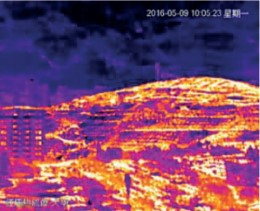
- Capturing infrared
In visible light imaging, visible light strikes an object and then the reflected light is captured and imaged by the camera.
However, thermal imaging is different. Heat from an object radiates outward as infrared radiation and is captured by the thermal camera. Finally, a visible image is generated by the circuit processing.
Visible light and infrared radiation are both components of the electromagnetic spectrum, but they are in different bands? Therefore, visible light cameras cannot capture infrared, and thermal cameras cannot capture visible light.

The electromagnetic spectrum

The composition of the thermal camera
The thermal camera is composed of a germanium lens, an infrared detector, a signal processing circuit, an image processing chip and a metal shell. There are many configurations of infrared detectors, from 80x60 to 1280x1024, which is the resolution of the thermal camera.
Since the wavelength of IR (infrared radiation) is much longer than that of visible light, a larger pixel size is required to receive the corresponding energy. Therefore, in the general physical volume, the resolution of detectors is much lower than that of visible light detectors. Also, infrared detectors are divided into cooled and uncooled types, depending on whether the detector is equipped with a cooler or not.

The technical advantages
- 7/24 Monitoring: No additional fill light, effective 24/7 monitoring.
- Anti-camouflage: Heat perception, ordinary camouflage has nowhere to hide.
- Environmental Friendly: Strong penetrating ability, easy to deal with rain, snow and fog.
- Excellent Detection Ability: Longer detection distance than conventional camera, small targets can be easily detected.
Technical limits
- Unable to penetrate the wall
In many movies, the agents use thermal cameras to "see what's going on behind the wall", which is a typical misunderstanding of thermal cameras. In fact, walls block infrared radiation. If we point the thermal camera at the wall, do we get the heat from the wall instead of the heat behind the wall? Of course, if a high temperature object inside or behind the wall causes a temperature difference in the wall, the thermal camera can detect it. The detection of house heating and leaks can be done according to this principle.
 Floor heating control
Floor heating control
- Glasses cause glare
Through the glass window, we can see the scenery outside the window, because visible light can easily pass through the glass. But infrared cannot work. When infrared meets the glass, it is reflected like a mirror. If we hold a thermal camera to detect the glass directly, it will detect the reflected image of ourselves instead of the heat on the other side of the glass.
The same principle applies to other reflective materials, such as smooth metal surfaces.
Note : Infrared light cannot pass through ordinary silica glass. However, some metallic glasses, such as germanium glass, can transmit infrared well. In fact, most thermal camera lenses use germanium glass.
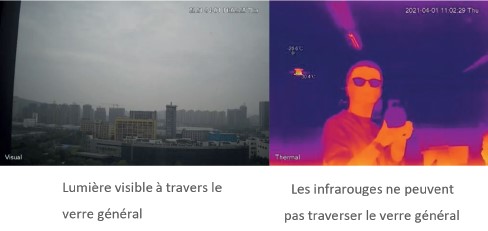
Thermal terminology
When you understand thermal imaging products and basic thermal imaging knowledge, you will come across many specific terms.
There are also some essential terms to understand the working principle and functional characteristics of thermal cameras, such as FOV, NETD, pseudo-color etc.
In this section, we will explain some important terms.
- Resolution: Refers to the number of pixels in the detector. Common thermal cameras have resolutions of 160x120, 256x192, 400x300, and 650x512. The higher the resolution, the sharper the thermal image.

- Pixel Size: The size of a single pixel. Thermal imaging pixel sizes used to be 35 microns, 25 microns, and 20 microns. Today, the pixel size of commonly used detectors is 17 microns or 12 microns.

- Detector type: In general, the most common detector in a thermal camera is vanadium oxide (VOx), and others include mercury cadmium tellurium (MCT), type II superlattice (T2SL), indium antimonide (InSb), etc.

NETD (Noise Equivalent Temperature Difference):
- What is NETD? What is the clarity?
It is a measure of the ability of a thermal imaging detector to distinguish very small differences in thermal radiation in the image. NETD is usually expressed in milli-Kelvin (mK). The smaller the value, the higher the performance of the detector.
- How is NETD measured?
In order to measure the NETD of a detector, the camera must be aimed at a temperature-controlled blackbody. The image on the left shows a noisy thermal image that the camera produces by looking at a very uniform blackbody during measurement. The image on the right shows a histogram of all pixel values taken from multiple images over time. This is a temporal distribution of the noise at this temperature. The NETD value is the standard deviation of this histogram (STDEV) converted to mK.

- Field of View (FOV): Taking the lens as the vertex, FOV is the angle formed by the two edges of the maximum range of the lens that the image of the measured object can pass through.
When the object to be observed is close or the monitoring range is wide, you can choose a product with a large FoV. When the object to be observed is far away or the monitoring range is narrow, you can choose a low FoV product.
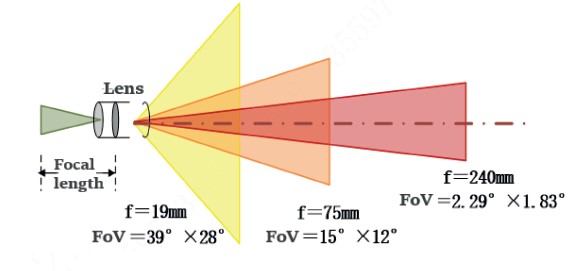
- Pseudo-color
We cannot see infrared light. Thermal cameras must convert detected infrared energy into images visible to the human eye, and use different colors to represent different temperatures. It is the pseudo-color.
Pseudocolors have many styles, and different pseudocolors have different expressions. Like white heat: the higher the temperature, the brighter the gray image. Rainbow: Colors are concentrated in the blue-green-red-yellow color range, the lower the temperature, the bluer the image, and the higher the temperature, the more yellow the image.

- Image merging
The data of the visible light channel and the thermal channel are superimposed, the gray information of the visible light image is retained, and the different temperatures are marked by pseudo-colors, so that the video image of the thermal channel is clearer.

FFC (Flat-Field Correction) or NUC (Non-uniformity Correction):
Flat field correction is also called shutter calibration. When the camera monitors a certain area for a long time, the image boundaries may display abnormally. In this case, the calibration of the shutter is useful. By closing the shutter baffle, the shutter provides a uniform temperature source to each pixel in the detection array.
During the calibration process, the camera updates the offset calibration coefficient to achieve a smoother image.
During this process, the thermal camera screen freezes for a short time. And at the same time it makes a "click", which is due to the lowering of the shutter.

Detection Range - Johnson Criteria
When choosing a thermal camera, people often ask, "How far can the camera see?" This is a very important question, but also a difficult question to clarify. The distance at which the camera can see is closely related to the size of the observed object, the environment where the observation equipment is located and the subjective judgment of the observer. Therefore, we have to introduce a standard of judgment and calculation to answer this question, which is Johnson's criterion. Johnson's criterion defines the minimum equivalent fringe resolution of the target, which is based on a 50% discrimination probability for an observer, to determine the recognition capability of the infrared thermal camera on the target. The target equivalent fringe can be understood simply as the number of pixels occupied by the image formed on the detection of targets can be divided into 3 levels:
- Detection: finding a target in the field of vision. At this time, the image formed by the target must occupy more than 3.6 pixels in the direction of the critical dimension.
- Recognition: The target can be classified, that is to say, we can recognize that the target is a tank, a truck or a person. That is, the target image must occupy more than 14 pixels in the direction of the critical dimension.
- Identification: The model and other characteristics that allow the target to be distinguished, for example to distinguish a friend or an enemy. That is, the target image must occupy more than 28 pixels in the direction of the critical dimension.

Application scenarios

Outdoor enthusiasts, animal and plant experts in nature exploration, in search of wild animals, due to the density of plants in the field, and animals that have a greater ability of mimicry concealment, alone with the naked eye or telescope visible light is difficult to find the animals. A thermal camera can easily identify a hidden animal by perceiving the difference between the animal's body temperature and the ambient temperature.
Introduction to outdoor products!
Monocular
Various models optional
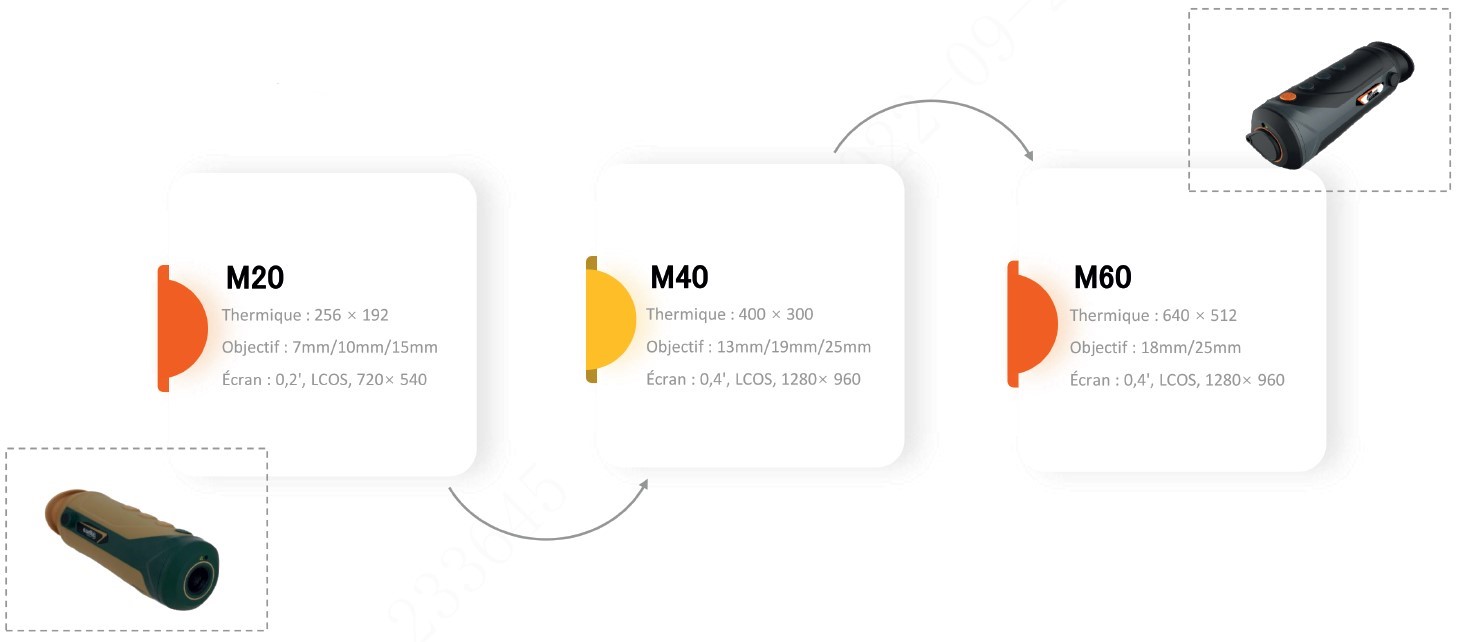
01 - Outstanding Image

With an industry-leading 12μm Vox sensor and a maximum resolution of 640*512, the Dahua M-series monocular achieves perfect display of target detail in any weather condition.
02 - Compact structure design

M series monocular adopts ergonomic structure, with proper hand feeling. It meets the IP67 rating, passes the 2 meter drop test, and can follow you in any environment.
03 - Long battery life
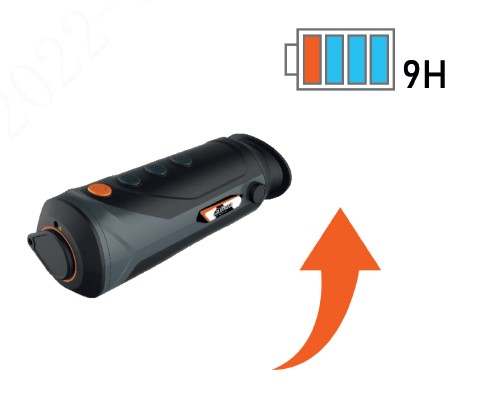
The M Series supports up to 9 hours of battery life*, and supports USB cable power, to ensure that you're in the field, it can always be available.
* M20 series supports 9h battery life and test environment is 25°C.
04 - Four color palettes

The M-series monocular offers a choice of four color palettes to meet your observation needs for different scenarios.
Warm white is suitable for observing active targets, Iron red can improve your long-term observation comfort in night conditions, Rainbow allows you to quickly identify targets, Alarm helps you detect quickly the emergence of high temperature targets.
05 - Fire detection

As a thermal camera, the M-series also offers automatic fire detection. Forest management staff can use it to carry out inspections, to detect fires early and organize staff to deal with them in time. It supports fire detection up to 1 km (fire size: 2m*2m).
06 - Distance measurement

It supports distance measurement function. By selecting the measurement target type and placing the measurement line on the top and bottom of the target, the approximate distance to the target can be obtained.
The target type can be wolf, human, rabbit or custom.
Pictures are not contractual. Photos of product may be different with the final products.
Texts, brands and characteristics are not contractual as they are liable to change depending on arrivals.
- Winchester: Choose your cartridges carefully depending on the game.
- Hunting “silencers”: Why approve them?
- Hera Arms Company - Presentation and product ranges
- Black Fire Company - Presentation and product ranges
- Lead-free cartridges!
- YILDIZ company - Presentation and product ranges
- Chiappa FireArms Company - Presentation and product ranges
- Renato Baldi Company - Presentation and product ranges
- Sierra: The different projectiles and their characteristics.
- Norma: the different warheads and their characteristics
- Shooting glossary
- The different types of warheads at Winchester: What does it correspond to?
- Weapons: definitions in the legal sense
- Red dot sights: How to choose?
- Regulations on chargers by the SCAE
- Archery: choose your arrow spin
- Company Davide Pedersoli - Presentation and product ranges
- Choose your thermal night vision
- SIA holder space user guide
- The different hunting modes
- The disciplines of sport shooting
- 5 tools for a good natural referencing of your website
- LE SIA : RGA et LPN - Les grandes étapes
- Paintball Vocabulary
- Legal information and regulations
- Comment les internautes ont trouvé notre site jusqu'à maintenant ?
- Ici, Europ-Arm répond à vos questions !
- Articles web - On parle de nous !
- Charte Europ-arm / Sport-attitude / Armsco de protection des données personnelles dans le cadre de la RGPD
- Europ-Arm helps to choose the right shotgun
- Le conseil de l'expert ! Comment bien choisir sa paire de jumelles ?
- Europ-Arm website support
- Catégories des armes
- Hunting and shooting whosaler
- Airsoft vocabulary
- Who are we ?